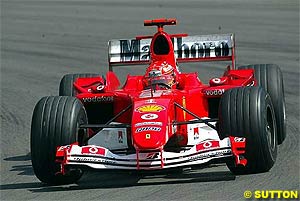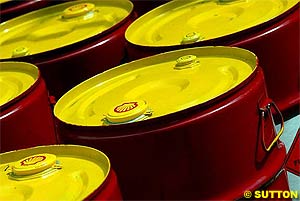Atlas F1 Magazine Writer
Fresh from the Formula One paddock
During the European Grand Prix weekend it came to light that, at last, qualifying is to be changed, with the first runs to the revised regulations taking place at the 11th race of the season, the British Grand Prix at Silverstone. A lot better late than never, you can hear the F1 chorus sing.
Well, a couple of things: first, the revised procedure needs agreement by the Formula One Commission, which next meets at end-June. Then, assuming F1's bigwigs approve the changes, it needs ratification (via a positive vote of at least 20 out of 25 voices) by the World Motor Sport Council, which meets shortly thereafter. More importantly, though, what chances, in any event, that the proposals will deliver, overall, a better spectacle than the present tedious arrangement? Exactly what is tabled?
As always, doubts exist as to the exact format proposed, which has changed more than a few times since first surfacing last Friday. Originally rumoured to consist of two 20-minute sessions - sandwiching a 20-minute break - during which each car must lap six times, the latest incarnation suggests two 25-minute sessions split by a 10-minute recess. In both instances, the fastest single laps set by each car during each session are to be aggregated to provide qualifying times, which will determine the grid. So, either way, the fastest cars overall will start from the front, and, in this day and age of virtually zero overtaking, is that really good thinking?
But, let us assume that all goes to plan, and that two 25-minute periods, with the 10-minute interval, are agreed to. Let us further assume that six laps need to be run in each session, and that the fastest individual laps from each session, by driver, decide the grid on an aggregate basis. Finally, let us assume that computer software exists to supply instant 'gratification', for that is exactly what 21st Century sports fans desire - instant access to failsafe results.
Not for them the tedium of calculating aggregates, nor for them the wait whilst results are checked and issued an hour later. Equally, split times were originally introduced to instill a sense of expectation, and these will now be meaningless unless a very complicated system tracks various permutations and presents them simply.
Simply, if you'll excuse the pun, the first runs will be all but meaningless - as they are in the present system - and the second runs meaningful only if very clear, accurate information is issued and broadcast immediately. Assuming each circuit contains three splits and that 20 drivers cover two competitive laps each (and two 'in's and 'out's per session), that entails an on-screen information system which supplies 120 coherent permutations in 25 minutes of overlapping runs. Will 300 million Joe Soaps, sipping Saturday afternoon cans of beer, actually understand what the highest-tech sport on Earth is coming to? Is not one of the major accusations against 2004 F1 one of boredom? Is not over-complication the easiest route to total boredom?
Of course, questions about the effects of the single engine rule can be thrown into this melting pot, particularly as regards fast lappery during weekends when motors need be preserved, but, by far the biggest question marks hangs over Parc Ferme, refueling and the 107% rule.
Present proposals have cars qualifying on low fuel, then taking in strategic quantities at some stage before the race. All well and good if the intention is to deliver flat out laps, but, if the goal is to 'spice' the show via qualifying unpredictability as it was when 'tanked cars' were introduced for the 2003 season and continued into this, then the revisions could well fail. Worse, they could spell the end of smaller teams. Why so?
One of the strengths of present Qualifying is that cars are visible to television audiences throughout their fast laps. This, of course, aids sponsor search and retention, as exposure is undeniable and quantifiable. With the 'six laps in 25 minutes' you can bet the cameras will not linger upon Zsolt Baumgartner's Minardi whilst Michael Schumacher is circulating, even if the Hungarian is on his fast one and the German reconnoitering.
Finally, what of the 107% rule? When tanked cars were mandated, the qualifying cut-off point, which had done so much to ensure a quality field, was suspended for obvious reasons. Now, if low fuel becomes the order of qualifying, there exists every reason to re-introduce the rule. And, although comparative qualifying performances are now impossible to guesstimate - due to varying fuel loads - the general consensus at the 'Newburgring' was that the likes of Jordan and Minardi will not, on present showings make the cut. Therein lies a dilemma: does F1 dumb down its fields merely to create a full grid of cars, or does it insist upon quality fields? Either way, the minnows will get hurt.
Now that F1 seems to be dropping tanked cars for qualifying and accepting that the fastest cars will start up front, why does it not take the opportunity of reverting to its old ways? Is there any reason why qualifying a la 2002 cannot be dragged off the mantelpiece and dusted down? Sure, the single engine rule complicates matters, but, by allowing teams a measure of discretion as to the number of laps they wish to run, that lamented qualifying buzz could be recreated, no problem. Here is the proposal:
Schedule qualifying for 14:00-15:00, during which cars run low fuel weights. Each car to run one lap minimum and a maximum of 12 laps. Starting grid to consist of only those who make the 107% cut, with fuel to be added before cars enter Parc Ferme. All other regulations remain as is.
Downsides? No more than during 2002 qualifying, which, forget not, saw six different drivers on the front row, including five on the trot by Juan Pablo Montoya, who failed to win a race. As for the hardships of smaller teams? If they could make 107% in 2002, they should be capable of that now, and if not, well, Arden and others are waiting in the wings...
Upsides? Just recall that buzz during Saturday's closing minutes every fortnight; now add in the strategic aspects: do drivers flash and dash for two or three laps, hoping their times do the trick come 15:00? Do they pound about for 12, seeking out hundredths here and there whilst praying their lumps do not betray them five laps from home on Sunday?
Perfect? Maybe not, but, as one team boss suggested over the weekend, anything is better than what F1 offers at present.
Two rather interesting rumours surrounded Ferrari at the Nurburgring: one that the Italian team had discovered a way of circumventing the FIA's tyre procedures, which stipulate that drivers make their choice of rubber before 09:00 on Saturday, to run soft compounds during qualifying, and hard during the race. Of course, Michael Schumacher's race strategy and pace absolutely disproved the rumourmongers, and Jean Todt's subsequent sideswipe at certain factions within the media was more than justified. Strangely, those who shouted loudest, had done the least research.
And, even before the race started, a senior Bridgestone man pointed out that any underhanded business of the type suggested (willful duplication of the tyre serial numbers and bar codes used to control usage) would, if uncovered, certainly see the tyre company banned from the sport forever and a day, and, as he said, "We rather like it in Formula One. So why would we risk something like when we're winning races and healthily leading both championship which have 11 events still to go, in any event?" Couldn't fault him.
Of course, they have had their splits over the years, the last one lasting until 1995, at which point Agip sponsored the Rampant Stallion and its pairing of Gerhard Berger/Jean Alesi. Shell, at that stage out of F1 after dominating via McLaren, Honda, Ayrton Senna and Alain Prost, was in the midst of corporate upheaval: not only over its alleged involvement in the Nigerian Ken Sarawiwa/Ogani Tribe affair, but also over the disposal of its Brent Spar oil rig, which Greenpeace occupied in the Atlantic after suggesting it would contaminate Norwegian and Scottish coast lines. The Ogani matter deteriorated chronically when human rights author Sarawiwa was mysteriously murdered; the vicious backlash over the rig led to Shell filling stations in Germany being bombed, apparently by Greens.
Corporate solution: sponsor a German driving for a mythical team in a sport enjoying worldwide coverage and popularity. And, let no one doubt that it is not a case of mission accomplished...
Which begs the question: just what does Shell glean from its continued involvement with Ferrari? Has saturation point not yet been reached? Of course the pairing wins, but it is rather bigger news when they it does not, and, at some point, that fantastic record of 43 starts (to date) without mechanical failure will come to an end.
Then there is the question of Ferrari's continued involvement in Formula One. As suggested by the Grapevine - and later by FIA president Max Mosley - Ferrari could leave the sport at some point. And what then with Shell, whose present contract with the team expires at the end of 2005? What of its further F1 aspirations?
The rumour was that Shell was looking at renewing its relationship with Honda, with whom, believe it or not, it had won its first Grand Prix way back in 1965. The form shown by BAR-Honda of late, plus the burgeoning reputations of Jenson Button and Taku Sato, make the team an extremely attractive partnership proposition. Certainly, a Honda man did not deny the possibility, saying that "we have a long historical relationship with Shell, and we would be more than willing to re-enter a partnership with the company." Honda does not now have a fuel sponsor.
The second possibility is Renault. Yes, of course, its majority shareholder is the French Government, as it is in present fuel sponsor, Elf, but the rumour in Germany was of a possible link-up. Again, its winning form must count for something, as do the profiles of Fernando Alonso and Jarno Trulli, and who knows exactly how competitive the outfit will still become? Then there is the question of Renault's 'first-fill' contract - the deal to fill the sumps and tanks of cars on the production line - which, in itself, makes for lucrative business.
So, watch this space. Just maybe there will be hundreds of used brown overalls for sale come end-2005.

 Others suggest that all six laps in each session will be counted and aggregated, but this fails to take into account 'in' and 'out' lap requirements, whilst totally overlooking the fact that certain teams seriously battle to make it through the present single flying lap procedure. Okay, so a new McLaren is en route, but it's the Merc's units that are detonating, and not Woking's best body bits...
Others suggest that all six laps in each session will be counted and aggregated, but this fails to take into account 'in' and 'out' lap requirements, whilst totally overlooking the fact that certain teams seriously battle to make it through the present single flying lap procedure. Okay, so a new McLaren is en route, but it's the Merc's units that are detonating, and not Woking's best body bits...
Run the weekend through to Saturday lunchtime as per the present, including prevailing engine, tyre and Parc Ferme restrictions, save for as below.

 The other, lesser known rumour surrounded the Italian marque's oil and fuel sponsor, Shell. Now, as any visit to Maranello will substantiate, the present relationship between the two companies extends to factory workers wearing both Prancing Horse and Shell logos on their caramel brown overalls. And, if it is the past one we're looking at, in July 1951 Froilan 'The Pampas' Bull' Gonzalez won Ferrari's first World Championship Grand Prix, using, of course, Shell products. A pretty longstanding partnership, then.
The other, lesser known rumour surrounded the Italian marque's oil and fuel sponsor, Shell. Now, as any visit to Maranello will substantiate, the present relationship between the two companies extends to factory workers wearing both Prancing Horse and Shell logos on their caramel brown overalls. And, if it is the past one we're looking at, in July 1951 Froilan 'The Pampas' Bull' Gonzalez won Ferrari's first World Championship Grand Prix, using, of course, Shell products. A pretty longstanding partnership, then.
|
Contact the Author Contact the Editor |
Please Contact Us for permission to republish this or any other material from Atlas F1.
|
Volume 10, Issue 22
Atlas F1 Exclusive
Interview with Anthony Davidson
Bjorn Wirdheim: Going Places
Ann Bradshaw: Point of View
2004 European GP Review
2004 European GP Review
Technical Review: Europe 2004
Deutschland Unter Alles
Team Players
Stats Center
Qualifying Differentials
SuperStats
Charts Center
Columns
The F1 Insider
Season Strokes
Elsewhere in Racing
The Weekly Grapevine
> Homepage |
